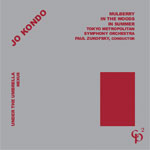Since the early 1970s, Jo Kondo's compositions have stood on a concept he has named "linear music" ("Sen no Ongaku"), i.e. music consisting of a "line" of single notes, hocketted over different instruments. Over the years, the "line" of notes has gradually evolved a much thicker texture, as if the "line" had been "harmonized". However, unlike conventional harmony, Kondo's "harmonizations" do not provide architectonic musical underpinnings; the sole role of these "harmonizations" (which provide a chord for each note of the "line") is to imbue every attack with a specific "color" or "quality". Given that there are only three possible chordal arrangements: (a) the chord "hangs down" from a "melody" note when that note is at the top of the chord; (b) the chord "stands" on the "melody" note when that note is the lowest note; (c) the chord wraps around the note; and further given that these three possible chord formations are freely ordered, the originally "thin" single line becomes embedded and integral within a chordal succession, which by definition is a "thick" single line. In the listening tradition of Western music, in a succession of chords (that are not exceedingly dense, complex, and/or cluster-like), one becomes accustomed to finding "part writing" (SATB as an example), even if that "part writing" was not of original intent. Kondo's music has no such part writing in mind; but one can nevertheless imagine, or pretend to discover, a transient, fragile, and nonstructural, "pseudo-polyphony". This psychological, accidental byproduct allows the composer ample room to create musical situations whose meaning and implications are far more deliberately ambiguous than those we are normally accustomed to; but this deliberate ambiguity mandates that the composite rhythm (i.e. the rhythm of all the parts taken together) assume a crucial personage, for unlike Western music, the overall "flow" of the performance is now the sole purview of the composite rhythm, as the composite has become the defacto "line".
Mulberry was written in 1998, and is dedicated to the memory of Toru Takemitsu. The work explores the juxtapositions, overlaps and superimpositions of the chordal material.
The orchestra of In the Woods (1989) is divided into two groups, each with a full complement of woodwinds, brasses, strings and percussion. The composition is characterized by the antiphonal treatment of the melodic/harmonic materials; by the note-to-note, hocket-like distribution (to different instruments) of the constituents of a single melodic line; and by the recurrences of constantly evolving thematic material.
In Summer was written in 2004, under commission from the Suntory Music Foundation, and was premiered in the Jo Kondo Composer's Portrait Concert held on October 7, 2004, at Suntory Hall, Tokyo, with the Tokyo Metropolitan Symphony Orchestra, conducted by Paul Zukofsky. Structurally, this work is the simplest of these three orchestral works. The composition is only a single melodic line of chord-colored successive tones, each section of the line cast in a different tempo. As there are no overlaps or chordal superimpositions, the composition is truly a line drawn by the single stroke of a thick brush.
Under the Umbrella (1976), was written for, and premiered by, the Canadian percussion group Nexus. The work requires 5 percussionists (for this premiere recording Bob Becker, Bill Cahn, Robin Engelman, Russ Hartenberger and John Wyre) playing 25 (untuned) cowbells ("almglocken"), and a gong. The work is in four movements. The first emphasizes rhythmic cells and their staggered repetition. The event-density is thick, and the tempo is fast. The second movement, because of its thinner texture and slower tempo, emphasizes the melodic content. The third movement has the slowest tempo and the thickest texture, with much interplay between strongly accented punctuations, and the use of "rolling" to produce sustained sounds; and this interplay emphasizes the timbral sound image arising from an ensemble of homogeneous sound sources (25 cowbells), which incorporates pitches that do not belong to any single conventional tuning system, and which also include a high content of non-tempered harmonics. The fourth movement, having the fastest tempo in combination with a thin texture akin to that of the second movement, once again emphasizes the melodic content. As the shortest movement, and coming as it does after the long, slow, and demanding third movement, this segment affords a final release to a composition about which Morton Feldman said "I think [it] is going to be another kind of classic as the years go by."
(PZ, April 2007)
TRACK LISTING
|
JO KONDO
|
| 1. |
Mulberry |
|
(12:17) |
| 2. |
In the Woods |
|
(14:03) |
| 3. |
In Summer |
|
(15:05) |
TOKYO METROPOLITAN SYMPHONY ORCHESTRA
PAUL ZUKOFSKY, CONDUCTOR
|
| Under the Umbrella
NEXUS
|
| 4. |
I |
|
(3:32) |
| 5. |
II |
|
(3.36) |
| 6. |
III |
|
(15:00) |
| 7. |
IV |
|
(1:40) |
CP2 Recordings
Jo Kondo: (1947--)
Publisher: University of York Music Press (U.K.)
Mulberry, In the Woods, and In Summer are edited versions (also including some rehearsal takes) of the "Jo Kondo Composer's Portrait Concert" of October 7, 2004, held in Suntory Hall, Tokyo, Japan.
Recording Engineer: Yukio Kojima
Edited and mastered by Paul Zinman at SoundByte Productions, Inc., NYC
All edit choices: Paul Zukofsky
All Pre and Post-production supervision: Paul Zukofsky
Under the Umbrella was recorded August 18, 1980, in the Norland, Ontario, Canada, geodesic-dome home of John Wyre. Each movement was recorded in one take, without edits. The recording was made using one microphone, Nexus having constructed a pentagonal rack, from each section of which hung each player's five "almglocken".
Recording Engineer: Tim Clark
Original Mastering (for LP CP2 #11: Robert C. Ludwig (Masterdisk Corp.))
In 2006, the recording was remixed and re-mastered by Paul Zinman at Soundbyte Productions, Inc., NYC.
CP2 123
© 2007 Musical Observations, Inc.
Mfg. by Musical Observations, Inc.
For information regarding our other releases, or Musical Observations, Inc. activities in general, please visit our website at www.musicalobservations.com.
|



